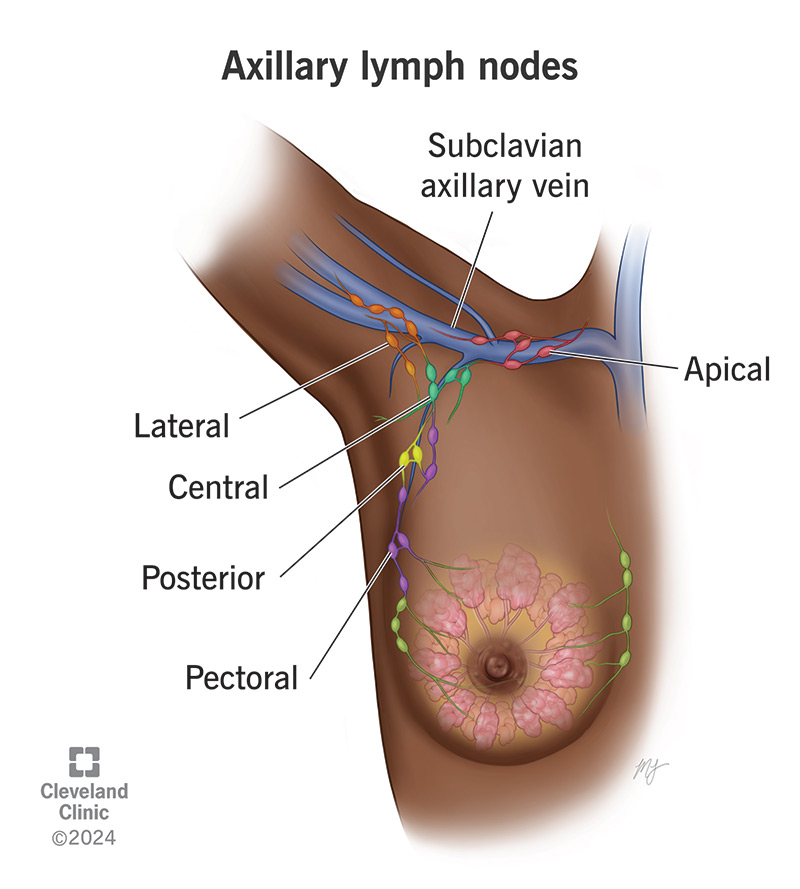An axillary lymph node dissection is surgery to remove lymph nodes from your armpit (axilla). Surgical oncologists do this surgery to determine the number of cancerous lymph nodes in your armpit. They may do this procedure as part of breast cancer surgery.
Advertisement
Cleveland Clinic is a non-profit academic medical center. Advertising on our site helps support our mission. We do not endorse non-Cleveland Clinic products or services. Policy

Your axillary lymph nodes act like a checkpoint for lymph draining from your arms, breasts and chest wall. Lymph is a watery, colorless fluid that, among other things, sweeps up cancer cells.
Advertisement
Cleveland Clinic is a non-profit academic medical center. Advertising on our site helps support our mission. We do not endorse non-Cleveland Clinic products or services. Policy
You have between 20 and 40 axillary lymph nodes located in several groups within each of your armpits. When you have breast cancer, your armpit (axillary) lymph nodes are generally the first place that cancer spreads (metastasizes).
Axillary lymph node dissection (ALND) is surgery to remove the lymph nodes in your armpit. Surgical oncologists do this surgery to see if cancer from your breast is in these nodes.
You may have this procedure as part of breast cancer surgery, like a lumpectomy or mastectomy. But in some situations, your oncologist will do ALND after surgery.
Your surgical oncologist may recommend you have this procedure as part of your breast cancer surgery if:
Advertisement
Your surgical oncologist will explain specific steps you should take before surgery, like whether you should stop eating and drinking (fasting). You’ll typically receive general anesthesia so you’re asleep during surgery.
To perform an axillary lymph node dissection, your surgical oncologist will:
This procedure is how your surgical oncologist finds out if there’s cancer in your axillary lymph nodes. If you have cancer in these lymph nodes, it can spread to other areas of your body.
Axillary lymph node dissection may affect your lymphatic system so it doesn’t move lymph through your body like it should. That can cause lymphedema (swelling in your arm). That swelling can lead to skin issues, like wounds and infections. Other potential axillary dissection complications include:
Your surgical oncologist may refer you to a lymphedema specialist as part of your treatment team to watch for signs or symptoms of lymphedema. These specialists can recommend ways to prevent it.
In general, a high number of cancerous axillary lymph nodes leads to a higher overall cancer stage. Node categories are:
But it’s important to remember the lymph node number is just one factor in staging breast cancer. Your surgical oncologist will also consider:
It’s not always easy to make sense of cancer staging. Don’t hesitate to ask your surgical oncologist to explain how the results may affect your situation.
Advertisement
Call your oncologist if you experience:
You’ve had a lot of questions and concerns since you got your cancer diagnosis. One question may be why you need to have an axillary lymph node dissection. Your surgical oncologist will explain the procedure to remove lymph nodes from your armpit. They’ll explain what impact test results may have on your treatment and situation. Axillary lymph node dissection is a step closer to having answers. And it can also be a big step toward your recovery.
Advertisement
A breast cancer diagnosis can turn your world upside down. At Cleveland Clinic, we offer expertise, compassion and personalized treatment plans.

Last reviewed on 10/27/2024.
Learn more about the Health Library and our editorial process.